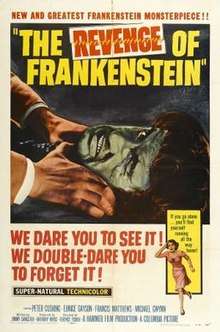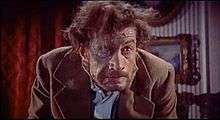The Revenge of Frankenstein
| The Revenge of Frankenstein | |
|---|---|
 Theatrical release poster | |
| Directed by | Terence Fisher |
| Produced by | Anthony Hinds |
| Written by | Jimmy Sangster |
| Starring |
Peter Cushing Francis Matthews Eunice Gayson Michael Gwynn |
| Music by | Leonard Salzedo |
| Cinematography | Jack Asher, B.S.C. |
| Edited by | Alfred Cox |
Production company | |
| Distributed by | Columbia Pictures |
Release date |
|
Running time | 89 min. |
| Country | United Kingdom |
| Language | English |
| Box office | 455,241 admissions (France)[1] |
The Revenge of Frankenstein is a 1958 British horror film made by Hammer Film Productions. Directed by Terence Fisher, the film stars Peter Cushing, Francis Matthews, Michael Gwynn and Eunice Gayson. In the US, it was released on a double feature with Curse of the Demon.[2]
The Revenge of Frankenstein was a sequel to The Curse of Frankenstein, the studio's 1957 adaptation of Mary Shelley's novel Frankenstein.
Plot
In 1860, Baron Victor Frankenstein, sentenced to death, escapes execution by the guillotine by having a priest beheaded and buried in his place, with the aid of one of his followers (the scuffle and substitution takes place offscreen, and is not realized until later). Three years later, Frankenstein, now going by the alias of Doctor Victor Stein, has become a successful physician in Carlsbruck, catering to the wealthy while also attending to the poor in a paupers' hospital. Hans Kleve, a junior member of the medical council, recognises him and blackmails him into allowing him to become his apprentice.
Together with Karl, the hunchback who facilitated Frankenstein's escape, Frankenstein and Kleve continue with the Baron's experiment: transplanting a living brain into a new body, one that is not a crude, cobbled-together monster. The deformed Karl is more than willing to volunteer his brain, thereby gaining a new, healthy body, particularly after meeting the new assistant at the hospital, the lovely Margaret.
The transplant succeeds, but when the excited Kleve tells Karl that he will be a medical sensation, Karl panics and convinces Margaret to free him. Kleve notes that the chimpanzee into which Frankenstein had transplanted the brain of an orangutan ate its mate, and worries about Karl, but his concerns are brushed off by Frankenstein.
Karl flees from the hospital and hides in Frankenstein’s laboratory, where he burns his preserved hunchback body. He is attacked by the drunken janitor, who takes him for a burglar, but manages to strangle the man. Frankenstein and Kleve discover Karl is missing and begin searching for him.
The next morning, Margaret finds Karl in her aunt's stable. While she goes to fetch Kleve, Karl experiences difficulties with his arm and leg. When Kleve and Margaret arrive, he is gone. At night, he ambushes and strangles a local girl. The next night, he rushes into an evening reception. Having redeveloped his deformities, he begs Frankenstein for help, using his real name, before collapsing and dying.
Frankenstein, disregarding Kleve's pleas that he should leave the country, appears before the medical council, where he denies being the infamous Baron Frankenstein. The unsatisfied councillors open Frankenstein's grave, only to discover the priest's body, and conclude that the real Frankenstein is still alive.
At the same time, frightened and angry patients at the hospital brutally attack Frankenstein and leave him for dead. Kleve rescues his dying mentor and rushes him to the laboratory, where he extracts Frankenstein's brain from his body just before the police arrive. Kleve shows them Frankenstein's dead body, claiming that he tried in vain to save his life. Alone again and uneasy about his skills, Kleve begins transplanting the brain into another body—one that Frankenstein had been preparing earlier and which was made to resemble him...
Sometime later in London, Kleve assists Frankenstein—now calling himself Doctor Franck—in welcoming some patients...

Cast
- Peter Cushing as Doctor Victor Stein
- Francis Matthews as Doctor Hans Kleve
- Eunice Gayson as Margaret
- Oscar Quitak as hunchback Karl, the "dwarf"
- Michael Gwynn as Karl in his new body
- John Welsh as Bergman
- Lionel Jeffries as Fritz
- Richard Wordsworth as Up Patient
- Charles Lloyd-Pack as President of the Medical Council
- George Woodbridge as Janitor
- Michael Ripper as Kurt
Production
According to Jimmy Sangster James Carreras presold the film in America taking a poster with him. When Carreras returned he approached Sangster with the project asking him to write the sequel. Sangster responded, "I killed (Baron) Frankenstein in the first film." Sangster stated that Carreras told him he had six weeks to write the project before shooting started and that "you'll think of something". [3]
The film was shot at Bray Studios and production commenced on January 6, 1958, three days after filming wrapped on Dracula (1958), which likewise starred Cushing and was directed by Fisher.[4]
Conductor and composer Leonard Salzedo was hired to write the score,[5] and most of the regular Hammer crew returned in other roles, including Jack Asher as cinematographer, Bernard Robinson on design and Phil Leakey on make-up.[6]
Novelization
Three novelizations of the film were published. The first one by Jimmy Sangster (using the pen name Hurford Janes) was published by Panther Books in 1958; the second was by John Burke as part of his 1966 Pan book The Hammer Horror Film Omnibus. A third novelization, by Shaun Hutson was published in March 2013 ( ISBN 9780099556237).
Critical reception
Variety called The Revenge of Frankenstein "a high grade horror film" with "rich" production values and a script that was "well-plotted, peopled with interesting characters, aided by good performances."[7] Motion Picture Daily noted, "a horror picture turned out with creative skill and imagination. The most notable contribution the Hammers have made to the genre is their stunning use of color for frightening effects". Hammer Films "have demolished once and for all the theory that horror films should always be in black-and-white".[8] Harrison's Reports declared it "a first-rate picture of its kind."[9] The Monthly Film Bulletin was negative, writing: "A contrived plot and a notable lack of pace and imagination are responsible for the failure of this lavish and painstaking production to be convincing even on the level of a horror film. Peter Cushing's stylish and diffident performance serves only to underline the farcical effects of a crude and pedestrian handling of the little legitimate horror left."[10]
The Revenge of Frankenstein currently holds a 92% approval rating on movie review aggregator website Rotten Tomatoes based on eight reviews.[11]
See also
References
- ↑ Box office information for Terence Fisher films in France at Box office Story
- ↑ Hallenbeck 2013, p. 106.
- ↑ "The British Entertainment History Project : Jimmy Sangster". Historyproject.org.uk. Retrieved 9 June 2018.
- ↑ Hallenbeck 2013, p. 101.
- ↑ Hallenbeck 2013, p. 105.
- ↑ Hallenbeck 2013, p. 229.
- ↑ "The Revenge of Frankenstein". Variety: 6. June 18, 1958.
- ↑ "The Revenge of Frankenstein - Motion Picture Daily". Archive.org. Retrieved 20 June 2015.
- ↑ "'The Revenge of Frankenstein' with Peter Cushing and Francis Matthews". Harrison's Reports: 98. June 21, 1958.
- ↑ "The Revenge of Frankenstein". The Monthly Film Bulletin. 25 (296): 117. September 1958.
- ↑ "The Revenge of Frankenstein – Rotten Tomatoes". Rotten Tomatoes. Retrieved 18 August 2012.
Sources
- Hallenbeck, Bruce G. (2013), The Hammer Frankenstein: British Cult Cinema, Midnight Marquee Press, ISBN 978-1936168330
External links
| Wikiquote has quotations related to: The Revenge of Frankenstein |